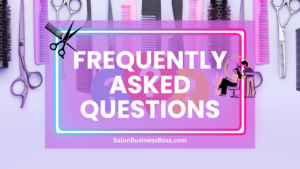Hair styling is an art form that holds a special place. Whether it’s a dramatic makeover, a subtle touch-up, or a trendy new look, people rely on skilled hair stylists to make them look and feel their best. If you’re passionate about hair and dream of owning your own salon or freelance business, it’s essential to have a solid hair stylist business plan in place.
To succeed in the competitive world of hairstyling, a well-crafted hair stylist business plan is essential. It’s your roadmap to financial stability and creative fulfillment in the salon industry.
In this article, we’ll walk you through every aspect of creating a business plan that will set you on the path to growth.
The Power of a Business Plan

Think of a business plan as a reliable guide for your journey as a hairstylist. It’s not just a list of what you want to do but a practical tool for making smart choices, getting financial support, and showing your dedication to potential investors or collaborators. In the hair styling world, creativity matters, but having a clear business plan is just as vital to ensure your career takes off.
Your plan will not only help you set clear goals and make informed decisions but also assist you in acquiring the funding you need to get started. It’s like having a detailed map for your salon or freelance business, ensuring you’re on the right track and ready to tackle any challenges that come your way. While your talent with hair is essential, a well-crafted business plan is your foundation for a thriving journey in the industry.
Read more about: Beauty Salon Consultancy Services: Empowering Salon Owners
Executive Summary
The executive summary is a concise overview of your hair stylist business plan. It should provide a snapshot of your business, including its mission, vision, and key points. Here’s what to include:
Mission and Vision
Start with a clear and inspiring statement of your business’s mission and vision. What is the purpose of your hair stylist venture, and what do you hope to achieve in the long run? Your mission and vision should reflect your passion for the industry and the unique value you bring to clients.
Business Description
Provide an overview of your hair styling business. Include details such as your business name, location, and a brief history (if applicable). Explain why you chose this business and what sets it apart from competitors.
Key Objectives
List your main objectives for the business. These could include financial goals, client retention targets, or expansion plans. Make sure your objectives are specific, measurable, achievable, relevant, and time-bound (SMART).
Products and Services
Describe the range of hair styling services you plan to offer. This may include haircuts, coloring, extensions, treatments, and styling for various occasions (e.g., weddings or events). Highlight any unique or specialty services you provide.
Target Market
Identify your target market. Who are your ideal clients, and what are their characteristics? Consider factors like age, gender, income level, and lifestyle. Understanding your target market is crucial for tailoring your services and marketing efforts.
Competitive Analysis

Analyze your competitors in the hair styling industry. Who are your main competitors, and what are their strengths and weaknesses? How do you plan to differentiate your business and stand out in the market?
Business Structure and Legal Considerations
In this section, outline the legal structure of your hair styling business. Discuss important legal and regulatory considerations, such as licenses, permits, and insurance.
Read more about: Beauty Salon Safety Checklist: Your Passport to Safe Glamour
Legal Structure
Determine the legal structure of your business. Common options include sole proprietorship, partnership, limited liability company (LLC), or corporation. Explain why you chose this structure and how it aligns with your business goals.
Licensing and Permits
Research the licensing and permit requirements for operating a hair styling business in your area. Provide details about the specific licenses and permits you need, and outline your plan for obtaining them.
Insurance
Discuss the types of insurance coverage you will need to protect your business, employees, and clients. This may include liability insurance, property insurance, and workers’ compensation insurance.
Market Research and Analysis
To build an effective hair styling business, you must thoroughly understand your target market and industry trends. This section focuses on market research and analysis.
Industry Overview
Provide an overview of the hair styling industry. Discuss its current state, trends, and growth potential. Include statistics and data to support your analysis.
Target Market Analysis
Expand on the target market information from the executive summary. Go into greater detail about your ideal clients, including their needs, preferences, and purchasing behavior. Use market research to back up your claims.
SWOT Analysis

Conduct a SWOT analysis for your hair stylist business. Identify your strengths, weaknesses, opportunities, and threats. This analysis will help you make informed decisions and develop strategies to capitalize on your strengths.
Marketing and Sales Strategy
Your marketing and sales strategy is crucial for attracting and retaining clients. Outline your approach to promoting your hair styling services and growing your customer base.
Read more about: Beauty Salon Cleaning Checklist: Crafting a Clean Canvas
Branding and Positioning
Define your brand identity and positioning in the market. What do you want your business to be known for, and how will you communicate this to your target audience?
Pricing Strategy
Determine your pricing strategy. Consider factors like your costs, competitors’ pricing, and the perceived value of your services. Will you offer different pricing tiers or packages?
Promotion and Advertising
Detail your marketing and advertising plans. How will you reach your target audience? Consider using a mix of online and offline channels, such as social media, email marketing, SEO, and traditional advertising.
Sales Strategy
Explain your sales approach. Will you offer special promotions or loyalty programs? Describe how you plan to convert leads into paying clients and encourage repeat business.
Operations and Management
This section covers the day-to-day operations of your hair styling business and the roles and responsibilities of your team, if applicable.
Location and Facilities
Describe the location of your salon or studio. Include details about the layout, decor, and any special features that enhance the client experience.
Equipment and Supplies
List the equipment, tools, and supplies you need to operate your business. Explain your sourcing and maintenance plan for these assets.
Staffing and Training

If you plan to hire employees, outline their roles and responsibilities. Describe your hiring process and any training programs you will implement to ensure high-quality service.
Inventory Management
Explain how you will manage inventory, especially if you offer retail products like hair care products or accessories.
Read more about: Beauty Salon Startup: Licensing Demands Explained
Financial Projections
In this section, provide detailed financial projections for your hair stylist business. This information is essential for potential investors or lenders and for your own financial planning.
Start-up Costs
List the initial costs required to launch your business. This may include equipment purchases, leasehold improvements, marketing expenses, and working capital.
Revenue Forecast
Create a revenue forecast for the first three to five years of your business. Estimate how many clients you will serve and the average revenue per client.
Expense Projections
Detail your projected operating expenses, including rent, utilities, insurance, marketing costs, and salaries. Be as realistic as possible in your estimations.
Cash Flow Statement
Prepare a cash flow statement that shows the movement of money in and out of your business. This will help you identify potential cash flow issues and plan for them.
Break-Even Analysis
Calculate your break-even point—the point at which your revenue equals your expenses. Knowing your break-even point helps you set financial goals and make informed decisions.
Funding and Financing

Discuss your funding and financing options for your hair stylist business. Whether you’re self-funding, seeking investors, or applying for loans, outline your strategy for securing the necessary capital.
Personal Investment
Explain how much of your own money you are investing in the business. Detail your personal financial commitment to demonstrate your dedication.
Read more about: Before the Scissors Snip: Salon Launch Advice
External Financing
If you plan to seek external financing, provide information about the sources you will approach, such as banks, investors, or crowdfunding platforms. Explain how you will use the funds and your repayment plan.
Financial Projections for Investors
If you’re presenting your business plan to potential investors, provide a separate section with detailed financial projections and a clear outline of the expected return on investment (ROI).
Risk Assessment and Mitigation
Acknowledge the potential risks and challenges your hair stylist business may face and describe how you plan to mitigate them.
Risk Assessment
Identify the key risks associated with your business, such as economic downturns, competition, or supply chain disruptions.
Risk Mitigation Strategies
For each identified risk, outline specific strategies to mitigate its impact. This may include diversifying your services, building a financial cushion, or implementing contingency plans.
Conclusion
Crafting a comprehensive hair stylist business plan is an essential step in turning your passion for hair styling into a thriving venture. A well-prepared plan will not only guide your business decisions but also make a compelling case to potential investors or lenders. By following the structure outlined in this guide and conducting thorough research and analysis, you’ll be on your way to creating a thriving hair styling business that fulfills your dreams and delights your clients. Remember that a solid plan, combined with dedication and creativity, can lead to a fulfilling career in the beauty industry.
Frequently Asked Questions

Q: What is the purpose of a business plan for a hair stylist?
A: A business plan for a hair stylist serves as a comprehensive roadmap for establishing and managing a hair styling business. It outlines key objectives, strategies, and financial projections, helping entrepreneurs make informed decisions and secure financing.
Q: What should be included in the market research section of a hair stylist business plan?
A: The market research section should encompass an analysis of the hair styling industry, including current trends, competition, and growth potential. It should also provide a detailed profile of the target market, highlighting client demographics, preferences, and behavior.
Q: Why is financial forecasting important in a hair stylist business plan?
A: Financial forecasting is crucial in a hair stylist business plan as it provides insights into the financial viability of the venture. It helps entrepreneurs estimate start-up costs, revenue projections, and operating expenses, aiding in budgeting and securing funding.
Q: How can a hair stylist business plan help in securing financing or investments?
A: A well-prepared hair stylist business plan acts as a persuasive tool for potential investors or lenders. It demonstrates a clear vision, market research, and financial projections, instilling confidence in financiers about the venture’s potential return on investment.
Q: Is a business plan necessary for a freelance hair stylist or independent contractor?
A: Yes, even freelance hair stylists benefit from having a business plan. It serves as a strategic tool to set goals, manage finances, and track progress. It can also be instrumental in securing partnerships, sponsorships, or collaborations in the beauty industry.
To learn more on how to start you own salon checkout my startup documents here.
The information provided by SalonBusinessBoss.com (“The Site”) is for general informational purposes only. All information on the Site is provided in good faith, however, we make no representation or warranty of any kind, express or implied, regarding the accuracy, adequacy, validity, reliability, availability or completeness of any information on the Site. Under no circumstance shall we have any liability to you for any loss or damage of any kind incurred as a result of the use of the Site or Reliance on any information provided on the Site. Your use of the Site and your reliance on any information on the Site is solely at your own risk. This blog post is for educational purposes only and does not constitute legal advice. Please consult a legal expert to address your specific needs. Terms and Conditions. (https://salonbusinessboss.com/terms-conditions/)

About the author. Entrepreneur and Salon Business Fan.
Hi! I am Shawn and I am a happy individual who happens to be an entrepreneur. I have owned several types of businesses in my life from a coffee shop to an import and export business to an online review business plus a few more and now I create online salon business resources for those interested in starting new ventures. It’s demanding work but I love it. I do it for those passionate about their business and their goals. That’s why when I meet a salon business owner, I see myself. I know how hard the struggle is to retain clients, find good employees and keep the business growing all while trying to stay competitive.
That’s why I created Salon Business Boss: I want to help salon business owners like you build a thriving business that brings you endless joy and supports your ideal lifestyle.

